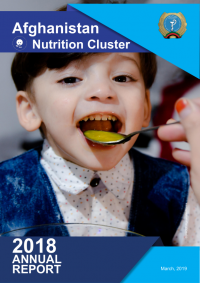Afghanistan Nutrition Cluster – Annual Report
The nutritional situation in Afghanistan continues to be alarming. Ongoing conflict, low access to basic services, and impact of natural disasters have exacerbated the existing vulnerabilities of communities, contributing towards high rates of acute malnutrition, which are reflected in severity of acute malnutrition map below….
 The nutritional situation in Afghanistan continues to be alarming. Ongoing conflict, low access to basic services, and impact of natural disasters have exacerbated the existing vulnerabilities of communities, contributing towards high rates of acute malnutrition, which are reflected in severity of acute malnutrition map below.
The nutritional situation in Afghanistan continues to be alarming. Ongoing conflict, low access to basic services, and impact of natural disasters have exacerbated the existing vulnerabilities of communities, contributing towards high rates of acute malnutrition, which are reflected in severity of acute malnutrition map below.
The findings of most recent nutrition surveys across Afghanistan show that 22 out of 341 provinces are currently above the emergency level threshold of acute malnutrition based on WHO classification of wasting rates for children under the age of five (global acute malnutrition (GAM) ≥10 per cent with aggravating factors)2 . The impact of drought in 2018 is likely to extend through mid-2019 (next harvest period), further aggravating the poor nutritional situation. Annually, an estimated 2 million children under the age of five and 485,000 pregnant and lactating women (PLW) are affected by acute malnutrition. About 75 percent of acute malnourished children under five are in twenty-two high priority provinces.
Children under the age of five and pregnant and lactating women (PLW) are the most vulnerable population groups to acute malnutrition. Among the 2 million children under the age of five years who are suffering from acute malnutrition in Afghanistan, a staggering 600,000 children (29 percent) are suffering from severe acute malnutrition (SAM), which is the most dangerous form of undernutrition in children. Children suffering from SAM are nine times more likely to die than their healthy peers and those suffering from prolonged undernutrition who survive may become locked in a cycle of recurring illness and faltering growth, with irreversible damage to their development and cognitive abilities. Women of reproductive age and adolescent girls affected by undernutrition have adverse effects on their own health as well as later on the birth outcome of infants, such as low birth weight (LBW) infants, causing inter-generational cycle of undernutrition.
Despite scale up of treatment of acute malnutrition services over the last years, a significant proportion of children with acute malnutrition continue to have no access to treatment. With the scale-up of services by Nutrition Cluster partners, the number of children receiving SAM treatment increased by 18 percent in 2018 compared to 2017. However, in 2018 only about 50 percent of SAM children and 30 percent of moderately acutely malnourished (MAM) children had access to treatment services. To date about 1 million acutely malnourished children under the age of five do not have access to treatment services. This is mainly due to lack of adequate resources and capacity to provide services through decentralized facilities, closer to communities.
 In Afghanistan, chronic vulnerability and undernutrition significantly overlap. Emergency needs must be addressed while building resilience and sustaining gains achieved by development interventions. A significant proportion of children suffer from various forms of undernutrition – 41 percent of children under the age of five years are chronically malnourished and 45 percent are anaemic (Afghanistan National Nutriton Survey, 2013).
In Afghanistan, chronic vulnerability and undernutrition significantly overlap. Emergency needs must be addressed while building resilience and sustaining gains achieved by development interventions. A significant proportion of children suffer from various forms of undernutrition – 41 percent of children under the age of five years are chronically malnourished and 45 percent are anaemic (Afghanistan National Nutriton Survey, 2013).
Humanitarian Context
A chaotic and unpredictable security situation, combined with a severe drought, have prompted an almost doubling in the number of people in need in 2019 compared to last year. By end of 2018 more than 550,000 civilians had been displaced and the number of people in need of emergency food assistance reached 3.6 million. In 2019, a total 6.3 million people require some form of humanitarian and protection assistance including 3.7 million in severe and major need due to a convergence of factors arising from exposure to escalating violence, forced displacement, the loss of essential livelihoods and limited access to basic services (OCHA Afghanistan, 2019 HNO).
Read the report: Afghanistan Nutrition Cluster – 2018 Annual Report